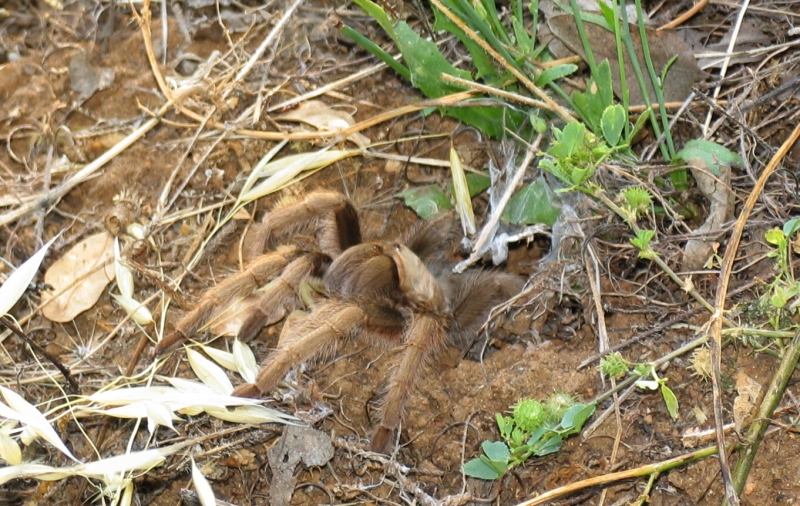
|
Ivan's Place |
|
Contact me
Home page
Table of Contents Tarantula!! |
|
The first three photos below are of two different tarantulas who set up housekeeping in abandoned gopher holes
in my yard. They are females, and are substantially heftier, and to my mind, substantially prettier than the
males. The
males are black, and have smallish abdomens in comparison to the females. The tarantuals generally seen walking
around on the surface are the males. When I was a kid growing up in the San Fernando Valley in the 50s, my
friends and I
would coax the males onto our hands and walk around with them as the spiders walked on our palms, which we
rotated escalator-fashion. Passing motorists almost always did a double-take. |
Here I lured the female out of the den by brushing the entrance with the dried oat straw seen bottom left. This picture shows clearly the chelicerae, the large forward-directed appendages which carry the tarantula's fangs on the underside. When I poke a stiff oat straw down into the den a bit, I can feel thumps as the spider hits at it with her fangs. I suspect that the chelicerae project a fair amount of force, and are somewhat flexible in directing the fangs at the spider's victim or attacker. |
|
|
Here the female has completely exited the den. Her eight eyes don't show well here, but the small cluster of dark dots at the top front of her shield-like carapace are her largest 4(?) eyes. I have no idea how good tarantula vision is. |
|
|
|
This is a different female. I had rattled her enough that she decided the den was actually under attack, and went into full defensive posture. This consists of filling the entire entrance with her body, fangs forward and ready to strike. I suspect that she is working blind here, and relies on a keen sense of touch to tell her when and where to strike. My guess is that if possible, she holds the victim or attacker with her front legs, and strikes multiple times with her fangs. I didn't even consider testng her ability to defend herself with my finger, nor did I further provoke her into striking at a straw. After a while she decided that the danger had passed and went back into the depths of the tunnel. Note the softish-appearing "toes" at the tips of her legs. |
|
|
|
Summer 2007. Below is one of two tarantula dens in my front yard. I left them alone, and as
I expected, after a while each female wove a barrier of silk across the entrance.
My best guess is that these were spun after the female had been impregnated by a male. |
|
|
|
July 17, 2007: I was right. A month later, the site above became rather messed up, with debris covering the formerly
well-formed plug and giving it the appearance of no longer even being there. But, I poked around a bit, and located the spongy section.
It felt firmer than before, so I decided to open it up. After some more poking and pushing, I broke through and began to
pull dirt out of the hole. When my middle and index finger were fully extended into the hole I felt a sharp sting on my
middle finger and yanked my hand back. Looking into the hole, I could see the female's legs just below the entrance. She was clearly
ready to spring again.
|
|
This is a male tarantula. The picture was taken years ago somewhere in the West San Fernando Valley. |
|
|
|
I believe this is what is called a Mexican Red-legged Tarantula. Isn't she beautiful? (I think it's a "she".) She was given to me as a gift. When I went to Central America in 1983, I entrusted her to friends, who decided they wanted to keep her after I returned. She lived to a ripe old age. |
|
|
|
Top Contact me Home page Table of Contents Page updated July 17, 2007 |